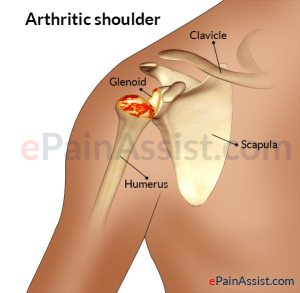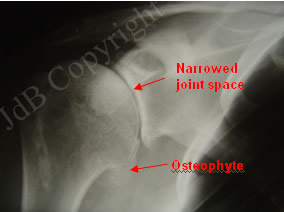The shoulder is made up of three bones: the humerus (upper arm bone), the scapula (shoulder blade), and the clavicle (collarbone). The body has a few ball-and-socket joints and the shoulder is one of them. The head of the humerus has a round end (or the ball) that smoothly fits into a shallow cavity on the scapula (or the socket). This shallow cavity or socket is also known as the glenoid cavity.
Cartilage is a smooth, protective tissue that protects the ends of the bones in the body, enabling them to gently glide. Additionally, inside the shoulder joint, there is a special tissue, the synovial membrane, that produces a small amount of fluid, nourishing and lubricating the cartilage, which helps eliminate friction.
Ligaments and tendons hold everything together in the body, like the stitching in your jeans holds your pants together! Simply said, ligaments connect bone to bone and tendons connect muscle to the bone.

What Part of My Shoulder is Being Replaced?
In general, when you undergo total shoulder arthroplasty (TSA or shoulder joint surgery) or total shoulder replacement, like in most operations, the injured parts are removed and replaced with a prosthetic. Specific to shoulder surgery, the surgical options traditionally are: replace the head of the humerus with a metal ball and the glenoid cavity with a plastic socket.
Medical Conditions That Can Damage the Shoulder Joint
There are several medical conditions that can cause someone to experience shoulder pain and discomfort. Overuse injuries from sports, like swimming or tennis, can damage the rotator cuff. Over time the shoulder joint remodels to adapt to the tear itself, which can sometimes lead to joint inflammation, deterioration, and pain. Typically, osteonecrosis (also known as avascular necrosis) is an extremely painful condition that develops when the blood supply to the head or ball of any joint is impaired. This most commonly happens to the hip joint (femoral head), but can affect the shoulder joint too.

Some common conditions that cause those with shoulder pain to consider TSA:
- Osteoarthritis
- Rotator cuff tear
- Avascular Necrosis
Osteoarthritis of the Shoulder
Shoulder osteoarthritis (OA) gradually develops along a continuum from mild to severe over several years and generally affects older individuals. However, younger people may also experience this after trauma to the joint. Usually, OA begins with cartilage loss that progresses, eventually causing joint inflammation and deterioration. Fluid around the shoulder (synovitis) and bone spurs (osteophytes) are signs of inflammation and deterioration, respectively.

When to Consider TSA?
If you have OA or a rotator cuff tear and traditional treatments are not working, you may want to consider TSA. Though, the decision to have surgery ultimately rests on your shoulders, talk with your healthcare provider, your orthopedic surgeon, and your family and friends before putting your John Hancock on the dotted line. TSA is a big operation and you will likely need support while recovering.
What is Reverse TSA?
For those with a diagnosis of a cuff tear arthropathy, at times shoulder surgery can be a little different. The TSA procedure is sometimes reversed (reverse TSA); the metal ball is attached to the scapula (instead of at the top of the arm) and the plastic socket is implanted at the top of the humerus (rather than to the glenoid cavity). Rotator cuff injuries cause joint degeneration, but the pathology is slightly different from OA because of the location of the injury itself. The rotator cuff uses specific muscles to move the arm and in large tears, these muscles can lose mobility over time. Reversing the procedure helps stabilize the shoulder joint, but differently; rather than using the rotator cuff to power the arm, the prosthesis depends on the deltoid muscle for its support. It’s important to mention that reverse shoulder surgery is also an option when traditional arthroplasty has failed in individuals with OA.

Improve Your Success After Surgery with Prehabbing Before
Whether an operation to remove a tooth or a surgery to replace a joint, for some recovery can be a long process. First and foremost, it’s important to mentally prepare yourself before going under to help reduce anxiety. Mindfulness techniques, like two 5-minute brain breaks a day, can help calm your mind and re-focus your attention on your health and well-being.
Here are some other things that you can do to improve your recovery:
- Improve your nutrition to improve your body’s ability to heal.
- Prehab exercises enhance your endurance and prepare your body for the stress of surgery.
What Can You Expect After Surgery?
Like with most operations, expect to feel some pain and remember that this is okay; it’s all a part of the healing process. Your orthopedic surgeon will most likely prescribe some pain medications, such as nonsteroidal anti-inflammatory drugs, to help relieve your pain and it’s important for you to take them if you have pain. When pain is severe it can prevent you from moving around and breathing deeply. Deep breathing, coughing and moving after surgery help keep your lungs clear, lowering your risk of developing postoperative pneumonia and reducing your risk of developing a blood clot in your legs.
Physical Therapy is Crucial to Your Recovery
Activity is a key component towards your recovery from a total shoulder replacement, especially during the first few weeks following the operation. It’s very important to follow your orthopedic surgeon’s and physical therapist’s exercise plan because it’s generally tailored to strengthen certain muscles, ligaments, and tendons surrounding the repaired joint.

Improved Quality of Life After Shoulder Arthroplasty
Many individuals are experiencing an improved range of motion and strength, less pain, and better function in their shoulder joints after a total shoulder replacement. If you have OA or have a rotator cuff tear and are still experiencing pain, talk with your healthcare provider or physical therapist at Cawley Physical Therapy and Rehabilitation and see if shoulder surgery is a safe option for you and your shoulder!
Looking for Relief today?? Click below to sign up for one of our limited Free Discovery Visits!

